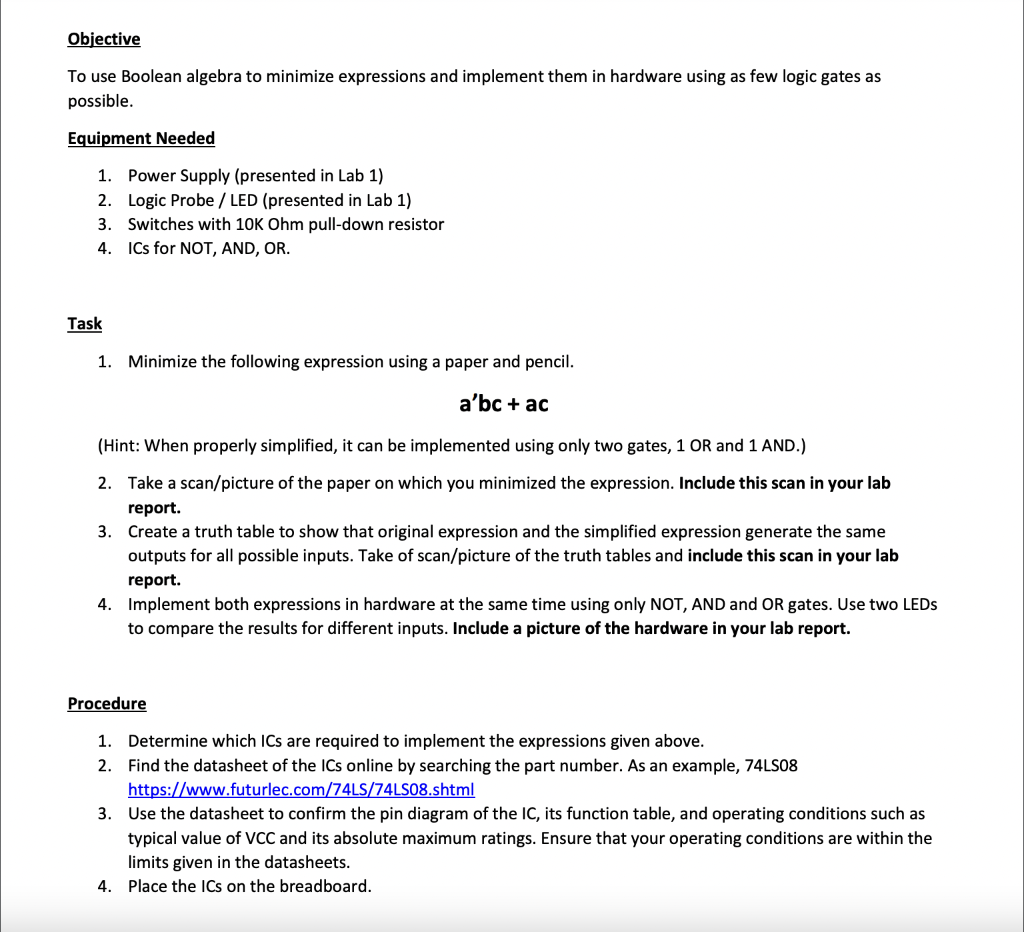Home /
Expert Answers /
Electrical Engineering /
please-use-tinkercad-to-design-the-circuit-thank-you-objective-to-use-boolean-algebra-to-mini-pa355
(Solved): Please use Tinkercad to design the circuit. Thank you! Objective To use Boolean algebra to mini ...
Please use Tinkercad to design the circuit. Thank you!
Objective To use Boolean algebra to minimize expressions and implement them in hardware using as few logic gates as possible. Equipment Needed 1. Power Supply (presented in Lab 1) 2. Logic Probe / LED (presented in Lab 1) 3. Switches with \( 10 \mathrm{~K} \) Ohm pull-down resistor 4. ICs for NOT, AND, OR. Task 1. Minimize the following expression using a paper and pencil. \( a^{\prime} b c+a c \) (Hint: When properly simplified, it can be implemented using only two gates, 1 OR and 1 AND.) 2. Take a scan/picture of the paper on which you minimized the expression. Include this scan in your lab report. 3. Create a truth table to show that original expression and the simplified expression generate the same outputs for all possible inputs. Take of scan/picture of the truth tables and include this scan in your lab report. 4. Implement both expressions in hardware at the same time using only NOT, AND and OR gates. Use two LEDs to compare the results for different inputs. Include a picture of the hardware in your lab report. Procedure 1. Determine which ICs are required to implement the expressions given above. 2. Find the datasheet of the ICs online by searching the part number. As an example, 74LSO8 https://www.futurlec.com/74LS/74LSO8.shtml 3. Use the datasheet to confirm the pin diagram of the IC, its function table, and operating conditions such as typical value of VCC and its absolute maximum ratings. Ensure that your operating conditions are within the limits given in the datasheets. 4. Place the ICs on the breadboard.
5. Connect \( +5 \mathrm{~V} \) to pin #14, and GND to pin #7 of the ICs. University of Jeddah 6. Connect the required number of switches to act as input, using a pull-down resistor. 7. Connect an LED between each output and ground through a resistor. 8. Patch the circuit. 9. Connect power supply to the breadboard and turn it ON. 10. Observe the outputs. Do they match your expected output? 11. Change the input combinations to verify if the truth table is correct. 12. For the lab report, take a picture of the hardware (including IC, Switches, and LEDs) providing evidence that the DeMorgan's Theorem works as expected.

